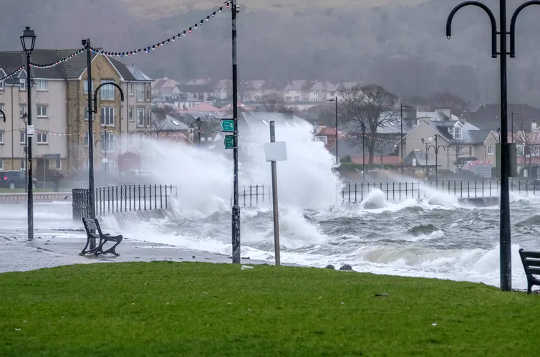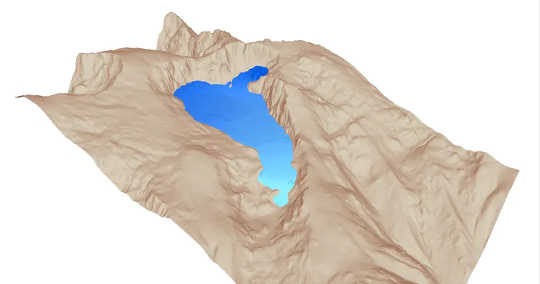
As the jet stream moves northwards, the UK can expect more storms and flooding in the winter. James McDowall/Shutterstock
The end of the last ice age, around 12,000 years ago, was characterised by a final cold phase called the Younger Dryas. Scandinavia was still mostly covered in ice, and across Europe the mountains had many more, and larger, glaciers than today. There was a substantial icefield in the west of Scotland and glaciers could be found on many mountains across the British Isles.
Not surprisingly, the climate was colder back then, especially in winter, with temperatures in the UK getting down to -30°C or lower. Despite these freezing ice-age winters, differences in the Earth’s orbit around the Sun meant the summers were relatively warm, with an average temperature in July between 7°C and 10°C across most of the UK and Ireland.
Then, as now, the polar front jet stream (a high-altitude fast-moving wind belt) had a major influence on the weather across Europe, bringing precipitation (rain and snow) from the Atlantic across the continent. However, before the time of written climate records, the timing, quantity and pattern of precipitation are poorly understood.
{vembed Y=Lg91eowtfbw}
Our new study has used glaciers that existed during the Younger Dryas to determine the precipitation patterns and path of the jet stream across Europe at that time. We identified glacial landforms called moraines at 122 sites from Morocco in the south to Norway in the north, and from Ireland in the west to Turkey in the east, which demonstrated the presence of glaciers some 12,000 years ago.
We reconstructed the 3D geometry of each of these glaciers using knowledge of the way that ice flows across the landscape. From the reconstructed ice surfaces, we could determine an important point on each of these glaciers, the equilibrium line altitude which is linked to climate via yearly precipitation and average summer temperature.
It is essentially the altitude on the glacier where snow accumulation and snow melt are equal at the end of September and can be seen as the snowline. The results provided a map of precipitation across Europe about 12,000 years ago which was controlled by the jet stream.
Jet stream weather
What the results showed was that the UK, Ireland, Portugal and Spain were mostly wetter than the present day, as was the Mediterranean, especially in the east – the Balkans, Greece and Turkey. It was relatively drier across much of France, Belgium, the Netherlands, Germany and farther east across Europe. These areas of wetter and drier climate allowed us to identify the location of the jet stream.
We surmised that the jet stream passed over the wetter regions bringing with it the storms (known as mid-latitude depressions) we are all familiar with in the UK – especially Scotland – and also potentially generated other smaller, more intense storms. Based on the path of the jet stream it is believed that the autumn and spring were wettest in the UK and Ireland and that the winters were drier.
Across Portugal, Spain and the Mediterranean, the winter months were probably the wettest, with autumn and spring being somewhat drier. This is the first time that we have had an insight into the seasonal weather patterns across Europe during the Younger Dryas, and indeed such glimpses of past climate, beyond the period for which we have recorded climate observations, are rare.
Normally it is only numerical climate models that reveal such a regional scale view on past atmospheric circulation, storm tracks and precipitation. Numerical climate models plot our weather and climate by dividing the atmosphere, Earth’s surface and ocean into multiple interconnected cells, vertically and horizontally, in a three-dimensional grid, and solve complex mathematical equations to determine how energy and matter move through the system.

A 3D reconstruction of the Cuerpo de Hombre palaeoglacier in the Central Range of the Iberian Peninsula. Brice Rea, University of Aberdeen, Author provided
Changing jet stream
In our study, a comparison of the glacier-derived precipitation from 12,000 years ago was made with the outputs from several palaeoclimate (the study of climate in the past) computer simulations. Numerical climate models are extremely complex, yet they remain a simplification of reality, so different models inevitably generate outputs which variously agree and disagree.
The general pattern of precipitation determined from our study of the palaeo-glaciers agreed with some parts of the climate model outputs, but in disagreement with others – for example, none of the climate models identified all of the UK, Ireland, Portugal, Spain and Mediterranean as being wetter in the past.
We are already seeing signs that the jet stream may be changing as the climate warms and it is thought that it will probably move northwards and become wavier. These ripples could lead to more extremes, for example, heatwaves in summer and more storms and flooding in the winter.
To understand how climate will change in the future we rely on computer models, but these models do not yet agree on what happened in the past nor on exactly what will happen in the future. To make better future predictions from ongoing climate warming, palaeoclimate datasets, such as the glacier-derived precipitation determined from our study, can be used to test the computer models.
When the models can better reproduce precipitation patterns reconstructed from past climates, especially in periods when the jet stream has moved, then our confidence in their predictions of future climate will also be boosted.
About the Author
Brice Rea, Professor, Geography, University of Aberdeen
This article is republished from The Conversation under a Creative Commons license. Read the original article.

Related Books:
The Future We Choose: Surviving the Climate Crisis
by Christiana Figueres and Tom Rivett-Carnac
The authors, who played key roles in the Paris Agreement on climate change, offer insights and strategies for addressing the climate crisis, including individual and collective action.
Click for more info or to order
The Uninhabitable Earth: Life After Warming
by David Wallace-Wells
This book explores the potential consequences of unchecked climate change, including mass extinction, food and water scarcity, and political instability.
Click for more info or to order
The Ministry for the Future: A Novel
by Kim Stanley Robinson
This novel imagines a near-future world grappling with the impacts of climate change and offers a vision for how society might transform to address the crisis.
Click for more info or to order
Under a White Sky: The Nature of the Future
by Elizabeth Kolbert
The author explores the human impact on the natural world, including climate change, and the potential for technological solutions to address environmental challenges.
Click for more info or to order
Drawdown: The Most Comprehensive Plan Ever Proposed to Reverse Global Warming
edited by Paul Hawken
This book presents a comprehensive plan for addressing climate change, including solutions from a range of sectors such as energy, agriculture, and transportation.























